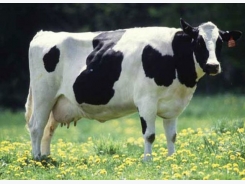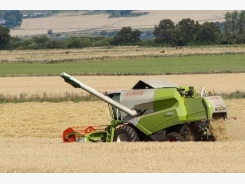Farm sector profitability forecast relatively stable

Cash receipts for broilers, hogs and cattle/calves are expected to see strong growth in 2017.
Nomadsould1/iStock/Thinkstock
After three consecutive years of decline, farm sector profits are projected to be relatively stable in 2017. Net farm income, a broader measure of profits, is projected to increase $1.7 billion (2.7%) from 2016 to $63.2 billion in 2017, and net cash income is expected to increase $3.7 billion (3.9%) to $96.9 billion, in nominal terms, according to the latest forecast released by the U.S. Department of Agriculture's Economic Research Service (ERS).
Inflation-adjusted net farm income is projected to be relatively unchanged from 2016, while inflation-adjusted net cash farm income is projected to rise 2.1%. The stronger forecast for growth in net cash farm income is largely due to an additional $2.1 billion (nominal) in cash receipts from the sale of beginning-of-the-year crop inventories. The net cash farm income measure counts those sales as part of current-year income, while the net farm income measure counts the value of those inventories as part of prior-year income.
Overall, cash receipts are projected to increase $8.6 billion (2.4%) in 2017 to $365.1 billion, reflecting a 7.6% increase in animal/animal product receipts. Most animal and animal product prices are expected to rise, and quantities sold are projected to increase as well.
The value of U.S. agricultural sector production is expected to rise $8.7 billion (2.2%) in 2017 to $407.8 billion. An expected increase of $11.3 billion (6.9%) in the value of animals/animal products and $3.3 billion in farm-related income more than offset a predicted $5.9 billion (3.1%) decrease in the value of crop production.
Livestock receipts
In particular, cash receipts for broilers, hogs and cattle/calves are expected to see strong growth in 2017 after posting significant declines in 2016.
Cash receipts are projected to be up $4.1 billion (15.9%) for broilers, up $3.5 billion (10.0%) for milk, up $1.6 billion (8.7%) for hogs and up $3.3 billion (5.2%) for cattle/calves. These gains reflect anticipated increases in both prices and quantities sold.
Total animal/animal product cash receipts are expected to rise $12.4 billion (7.6%) to $175.3 billion in 2017. “This increase reflects strong gains in receipts for meat animals, milk and poultry/eggs,” ERS reported.
Milk receipts are expected to increase $3.5 billion (10%) in 2017, reflecting expected increases in both the price and quantity sold. Cash receipts from cattle and calves are expected to increase $3.3 billion (5.2%) from 2016 as cattle/calf prices and quantities sold rise. Hog prices and quantities sold are both expected to rise in 2017, leading to a forecasted increase in hog cash receipts of $1.6 billion (8.7%).
Broiler receipts are expected to rise $4.1 billion (15.9%) as both prices and quantities sold increase in 2017. Chicken egg receipts are expected to rise $900 million (14.2%) as both egg prices and quantities sold increase in 2017. Turkey receipts are expected to decline $1.3 billion (20.4%) in 2017, reflecting a sharp price drop softened by a marginal increase in quantity sold.

Crop receipts
Crop cash receipts in total are projected to fall $3.8 billion (2%) from 2016 levels to $189.9 billion, largely due to expected declines in prices for some crops. The forecasts for fruit/nut and soybean cash receipts decreased $4.4 billion (15.3%) and $3.2 billion (7.6%), respectively. Partially offsetting these decreases, cash receipts are projected to be up $2.2 billion (37.2%) for cotton and up $1.5 billion (7.8%) for vegetables/melons.
Crop cash receipts — the cash income from crop sales during the 2017 calendar year — are projected to be $189.9 billion, a decrease of $3.8 billion (2.0%) from 2016.
Corn receipts are expected to decline $200 million (0.5%) in 2017 (dropping for the fifth consecutive year) as the U.S. average corn price is expected to drop from 2016 to 2017.
Despite an expected increase in wheat prices, wheat receipts are expected to decline $500 million (5.8%) from 2016 due to an anticipated decline in wheat quantities sold.
Lower soybean receipts of $3.2 billion (down 7.6%) in 2017 reflect a decline in quantity sold that more than offsets higher soybean prices.
Production expenses
Price changes (the price effect) from 2016 to 2017 for crops and animals/animal products are expected to account for a $2.6 billion increase in commodity cash receipts — the combined effect of a $7.2 billion increase in animal/animal product receipts and a $4.6 billion decline in crop receipts due solely to annual price changes.
“The quantity effect is over twice as large and is expected to increase cash receipts by $5.4 billion in 2017: $5.0 billion from additional quantities sold of animal/animal products and ($400 million) from additional quantities of crops sold,” ERS said.
After reaching record highs exceeding $390 billion in 2014, farm sector production expenses (including operator dwellings) declined by more than $40 billion the next two years. Following a total of $350 billion in 2016, production expenses for 2017 are projected to be higher at $356 billion. Continued projected declines in expenses for inputs typically produced on farms — including feed and livestock/poultry — will be more than offset by forecasted increases in fuel, labor and interest expenses.
Livestock and poultry purchases are expected to increase for the first time since 2014.
ERS also is forecasting a double-digit increase (13.8%) in spending on fuels and oils, which accounts for less than 5% of cash expenses. If realized, this would reverse the recent trend of lower fuel expenses over the last two years. ERS said this forecast is driven, in part, by the U.S. Energy Information Agency's forecast for higher diesel prices (by more than 30 cents/gal., on average) in 2017.

Interest expenses (including operator dwellings) are expected to increase 12.3% in 2017, driven by higher projected debt levels and rising interest rates on new and variable-interest rate debt.
Có thể bạn quan tâm
Phần mềm

Phối trộn thức ăn chăn nuôi

Pha dung dịch thủy canh

Định mức cho tôm ăn

Phối trộn phân bón NPK

Xác định tỷ lệ tôm sống

Chuyển đổi đơn vị phân bón

Xác định công suất sục khí

Chuyển đổi đơn vị tôm

Tính diện tích nhà kính

Tính thể tích ao hồ



 Integrated strategies power new future for poultry production
Integrated strategies power new future for poultry production  New rules for all farmers in England from…
New rules for all farmers in England from…